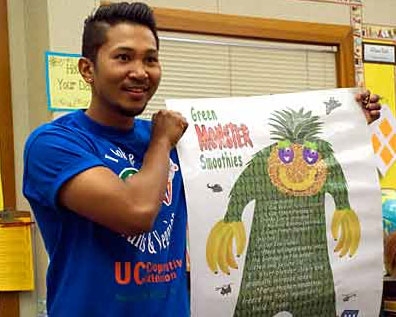University of California Cooperative Extension nutrition educator Marc Sanchez brings the fearsome beast with him on school visits to classrooms in Merced and Stanislaus counties.
“Let me introduce to you the Green Monster,” Sanchez says to a classroom of second-graders at Yamato Colony Elementary School in Livingston. “Is anybody scared?”
“Noooo,” the kids roar in defiance of the beast.

The school visits are just one of the ways UC researchers, educators and cooperative extension representatives across the state are encouraging children and their families to eat healthier. They also are introducing them to fresh produce, doing cooking demonstrations and helping school districts prepare healthier meals.
About 17 percent of American children and adolescents are obese, according to the Centers for Disease Control and Prevention. During the last 30 years, obesity rates have more than doubled for children ages 6 to 11 and tripled for adolescents ages 12 to 19. It's an ominous statistic that could be improved if children ate more fruits and veggies.
Connecting schoolkids to farmers
UC's nutrition education programs try to promote better eating habits by connecting schools to local farms and farmers. Known as farm-to-school programs, students learn about where their food comes from and how it's grown — and in the process, learn to eat a balanced diet. Often, the children then become the conduit that brings healthier eating to the whole family.
“UC is on the forefront of these programs,” said Theresa Spezzano, UC Cooperative Extension director for Stanislaus and Merced counties and a nutrition, family and consumer science adviser. “The majority of the work is in some sort of school-based program.”
Nutrition education from UC reaches children, families and classrooms in nearly every part of the state.
Cooperative Extension, part of UC's Division of Agriculture and Natural Resources, runs two federal programs for low-income families in California — the Expanded Food and Nutrition Education Program and the CalFresh Nutrition Education Program. Together they reach more than 180,000 people.
Changing the corner store
At UCLA, public health professor Alex Ortega leads an effort to make more healthy food available in low-income urban areas by working with neighborhood convenience stores to replace junk food with fresh fruits and vegetables.
The project is based in East Los Angeles — a predominately Mexican-American community where diabetes and obesity rates are high. Four stores have agreed to restock their shelves and refrigerators. In return, storeowners are being trained in how to market fresh fruits and vegetables. There is also an outreach program that uses local high school students to educate nearby residents about healthy eating and what's available at the transformed markets.
“It's just one part of a very complex puzzle. We understand other things have to be going on, including promoting more physical activity,” said Ortega, director of the UCLA Center for Population Health and Health Disparities that is funded by the National Heart, Lung and Blood Institute. “Providing access to healthy food is significant part of the puzzle. If people don't have access and health education, you can't expect the community to be eating healthy.”
Ortega said data are being gathered on the effectiveness of the five-year project in East Los Angeles. But even if they don't find extensive shifts in behavior, “just getting people in the community thinking about eating healthier is a major step,” he said.
Education + access = healthy choices
Although there have been few long-term studies on the effectiveness of nutrition education programs, one small study of four schools in Sacramento and Stanislaus counties suggests that farm-to-school education and access to healthier food can help lower obesity rates among children.
The schools are taking part in a UC Davis and Cooperative Extension program called Shaping Healthy Choices, which includes an exercise component, along with nutrition education and access to more fresh produce.
That kind of multi-component program is “a promising model for how schools can play a role in promoting healthy food choices and reducing childhood obesity,” said Sheri Zidenberg-Cherr, co-director of the Center for Nutrition in Schools at UC Davis, who helped lead the study.
In Sanchez's experience, the best way to reach kids is to make eating healthy food a positive experience and one they are likely to remember.
“I can tell them, ‘eat this because it's better for you,' but they hear that all the time,” he said. “I want to do something that catches their eye. What's more appealing, calling it a Green Monster or a spinach drink?”
View a slide show below to experience Marc Sanchez' interaction with children as he teaches healthful eating: